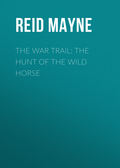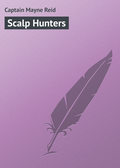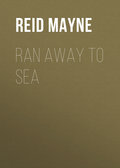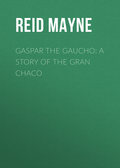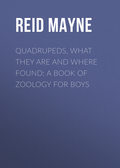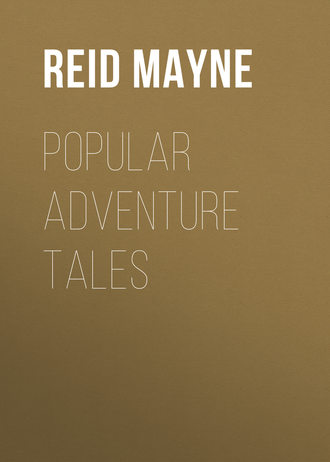
Майн Рид
Popular Adventure Tales
CHAPTER XLI.
THE WEAVER-BIRDS
Now that the beasts of prey had been destroyed, or driven from about the camp, there was no longer any danger in that quarter, and the children could be left by themselves. Totty of course always stayed with them; while the four hunters went forth upon the chase of the elephant – each mounted upon his quagga.
They had done so many a time, and as no harm had happened to the children in their absence, such a course became habitual with them. Jan and Trüey were cautioned not to stray far from the nwana, and always to climb to the tree, should they perceive any animal that might be dangerous. Before the destruction of the hyenas and lions, they had been used to remain altogether in the tree, while the hunters were absent. But this had been quite an imprisonment to them; and now that the danger was not considered much, they were allowed to come down and play upon the grassy plain, or wander along the shore of the little lake.
On one occasion when the hunters were abroad, Trüey had strayed down to the edge of the water. She was alone, if we except the company of the gazelle, which followed at her heels wherever she went. This pretty creature had grown to full size, and had turned out a great beauty, with large round eyes that had a lovely melting expression, like the eyes of Trüey herself.
Well, as I have said, Trüey was alone. Jan was busy near the bottom of the tree, working a new rod into his bird-cage, and Totty was out upon the plain herding “old Graaf” – so Trüey and the pet springbok went strolling along by themselves.
Now Trüey had not gone down to the water without an object. She had one. She had gone to give her pet a drink, and collect some blue lilies for a bouquet. All this she had done, and still continued to walk along the shore.
On one side of the lake, and that the farthest from the nwana-tree, a low spit of land projected into the water. It had once been but a sand-bar, but grass had grown upon it, until a green turf was formed. There was not over a square perch of it altogether, but it was not square in shape. On the contrary, it was of oval form, and much narrower nearest the land, where it formed a neck, or isthmus, not more than three feet in width. It was, in short, a miniature peninsula, which by a very little work with the spade could have been converted into a miniature island – had that been desired.
Now there is nothing very remarkable about a little peninsula projecting into a lake. In nearly every lake such a thing may be seen. But about this one there was something remarkable.
Upon its extreme end grew a tree of singular form and foliage. It was not a large tree, and its branches drooped downwards until their tips almost touched the water. The pendulous boughs, and long lanceolate silvery leaves, rendered it easy to tell what sort of tree it was. It was the weeping or Babylonian willow – so called, because it was upon trees of this species that the captive Jews hung their harps when they “sat and wept by the streams of Babel.” This beautiful tree casts its waving shadow over the streams of South Africa, as well as those of Assyria; and often is the eye of the traveller gladdened by the sight of its silvery leaves, as he beholds them – sure indications of water – shining afar over the parched and thirsty desert. If a Christian, he fails not to remember that highly poetical passage of sacred writing, that speaks of the willow of Babylon.
Now the one which grew upon the little peninsula had all these points of interest for little Trüey – but it had others as well. Upon its branches that overhung the water a very singular appearance presented itself. Upon these was suspended – one upon the end of each branch – a number of odd shaped objects, that hung drooping down until their lower ends nearly rested upon the surface of the water. These objects, as stated, were of a peculiar shape. At the upper ends – where they were attached to the branches – they were globe-shaped, but the lower part consisted of a long cylinder of much smaller diameter, and at the bottom of this cylinder was the entrance. They bore some resemblance to salad-oil bottles inverted, with their necks considerably lengthened; or they might be compared to the glass retorts seen in the laboratory of the chemist.
They were each twelve or fifteen inches in length, and of a greenish colour – nearly as green as the leaves of the tree itself. Were they its fruit?
No. The weeping willow bears no fruit of that size. They were not fruit. They were nests of birds!
Yes; they were the nests of a colony of harmless finches of the genus Ploceus, – better known to you under the appellation of “weaver-birds.”
I am sure you have heard of weaver-birds before this; and you know that these creatures are so called on account of the skill which they exhibit in the construction of their nests. They do not build nests, as other birds, but actually weave them, in a most ingenious manner.
You are not to suppose that there is but one species of weaver-bird – one kind alone that forms these curious nests. In Africa – which is the principal home of these birds – there are many different kinds, forming different genera, whose hard names I shall not trouble you with. Each of these different kinds builds a nest of peculiar shape, and each chooses a material different from the others. Some, as the Ploceus icterocephalus, make their nests of a kidney shape, with the entrance upon the sides, and the latter not circular, but like an arched doorway. Others of the genus Plocepasser weave their nests in such a manner, that the thick ends of the stalks stick out all around the outside, giving them the appearance of suspended hedgehogs; while the birds of another genus closely allied to the latter, construct their nests of slender twigs, leaving the ends of these to project in a similar manner. The “social grosbeak” fabricates a republic of nests in one clump, and all under one roof. The entrances are in the under-surface of this mass, which, occupying the whole top of a tree, has the appearance of a haystack, or a dense piece of thatch.
All these weaver-birds, though of different genera, bear a considerable resemblance to each other in their habits. They are usually granivorous, though some are insectivorous; and one species, the “red-billed weaver bird” is a parasite of the wild buffaloes.
It is a mistake to suppose that weaver-birds are only found in Africa and the Old World, as stated in the works of many naturalists. In tropical America, birds of this character are found in many species of the genera Cassicus and Icterus, who weave pensile nests of a similar kind upon the trees of the Amazon and Orinoco. But the true weaver-birds – that is to say, those which are considered the type of the class, – are those of the genus Ploceus; and it was a species of this genus that had hung their pendulous habitations upon the weeping willow. They were of the species known as the “pensile weaver-bird.”
There were full twenty of their nests in all, shaped as already described, and of green colour – for the tough “Bushman's grass,” out of which they had been woven, had not yet lost its verdant hue, nor would it for a long time. Being of this colour, they actually looked like something that grew upon the tree, – like great pear-shaped fruits. No doubt from this source have been derived the tales of ancient travellers, who represented that in Africa were trees with fruits upon them, which, upon being broken open, disclosed to view either living birds or their eggs! Now the sight of the weaver-birds, and their nests, was nothing new to Trüey. It was some time since the colony had established itself upon the willow-tree, and she and they had grown well acquainted. She had often visited the birds, had collected seeds, and carried them down to the tree; and there was not one of the whole colony that would not have perched upon her wrist or her pretty white shoulders, or hopped about over her fair locks, without fear. It was nothing unusual to her to see the pretty creatures playing about the branches, or entering the long vertical tunnels that led upward to their nests – nothing unusual for Trüey to listen for hours to their sweet twittering, or watch their love-gambols around the borders of the vley.
She was not thinking of them at the moment, but of something else, perhaps of the blue water-lilies – perhaps of the springbok – but certainly not of them, as she tripped gaily along the edge of the lake.
Her attention, however, was suddenly attracted to the birds.
All at once, and without any apparent cause, they commenced screaming and fluttering around the tree, their cries and gestures betokening a high state of excitement or alarm.
CHAPTER XLII.
THE SPITTING-SNAKE
“What can be the matter with my pretty birds?” asked Trüey of herself. “Something wrong surely! I see no hawk. Perhaps they are fighting among themselves. I shall go round and see. I shall soon pacify them.”
And so saying she mended her pace; and passing round the end of the lake, walked out upon the peninsula until she stood under the willow.
There was no underwood. The tree stood alone upon the very end of the spit of land, and Trüey went close in to its trunk. Here she stopped and looked up among the branches, to ascertain what was causing so much excitement among the birds.
As she approached, several of the little creatures had flown towards her, and alighted upon her arms and shoulders; but not as was their wont when desiring to be fed. They appeared to be in a state of alarm, and had come to her for protection.
Some enemy certainly must be near, thought Trüey, though she could see none.
She looked around and above. There were no hawks in the air, nor on the neighbouring trees, – no birds of prey of any kind. Had there been one in the willow, she could easily have seen it, as the foliage was light and thin; besides a hawk would not have remained in the tree with her standing so near. What, then, caused the trouble among the birds? what was still causing it – for they were as noisy and terrified as ever? Ha! At last the enemy appears – at last Trüey's eyes have fallen upon the monster who has disturbed the peaceful colony of weavers, and roused them to such a pitch of excitement.
Slowly gliding along a horizontal branch, grasping the limb in its many spiral folds, appeared the body of a large serpent. Its scales glittered as it moved, and it was the shining of these that had caught Trüey's eyes, and directed them upon the hideous reptile.
When she first saw it, it was gliding spirally along one of the horizontal branches of the willow, and coming, as it were, from the nests of the birds. Her eyes, however, had scarce rested upon it, before its long slippery body passed from the branch, and the next moment it was crawling head-foremost down the main trunk of the tree.
Trüey had scarce time to start back, before its head was opposite the spot where she had stood. No doubt, had she kept her place she would have been bitten by the serpent at once; for the reptile, on reaching that point, detached its head from the tree, spread its jaws wide open, projected its forked tongue, and hissed horribly. It was evidently enraged – partly because it had failed in its plundering intentions, not having been able to reach the nests of the birds, – and partly that the latter had repeatedly struck it with their beaks – no doubt causing it considerable pain. It was further provoked by the arrival of Trüey, in whom it recognised the rescuer of its intended victims.
Whatever were its thoughts at that moment, it was evidently in a rage – as the motion of its head and the flashing of its eyes testified; and it would have sprung upon any creature that had unfortunately come its way.
Trüey, however, had no intention of getting in its way if she could avoid it. It might be a harmless serpent for all she knew; but a snake, nearly six feet in length, whether it be harmless or venomous, is a terrible object to be near; and Trüey had instinctively glided to one side, and stood off from it as far as the water would allow her.
She would have run back over the narrow isthmus; but something told her that the snake was about to take that direction, and might overtake her; and this thought induced her to pass to one side of the peninsula, in hopes the reptile would follow the path that led out to the mainland.
Having got close to the water's edge, she stood gazing upon the hideous form, and trembled as she gazed.
Had Trüey known the character of that reptile, she would have trembled all the more. She saw before her one of the most venomous of serpents, the black naja, or “spitting-snake” – the cobra of Africa – far more dangerous than its congener the cobra de capello of India, because far more active in its movements, and equally fatal in its bite.
Trüey knew not this. She only knew that there was a great ugly snake, nearly twice her own length, with a large open mouth, and glistening tongue, apparently ready to eat her up. That was fearful enough for her, poor thing! and she gazed and trembled, and trembled and gazed again.
Angry as the cobra appeared, it did not turn aside to attack her. Neither did it remain by the tree. After uttering its long loud hiss, it descended to the ground, and glided rapidly off.
It made directly for the isthmus, as if intending to pass it, and retreat to some bushes that grew at a distance off on the mainland.
Trüey was in hopes that such was its design, and was just beginning to feel safe again, when, all at once, the snake coiled itself upon the narrow neck of land, as if it intended to stay there.
It had executed this manœuvre so suddenly, and so apparently without premeditation, that Trüey looked to discover the cause. The moment before, it was gliding along in rapid retreat, its glistening form stretched to its full length along the earth. The next instant it had assumed the appearance of a coiled cable, over the edge of which projected its fierce head, with the scaly skin of its neck broadly extended, into that hood-like form which characterises the cobra.
Trüey, we have said, looked for the cause of this sudden change in the tactics of the reptile. She learnt it at the first glance.
There stretched a piece of smooth sloping ground from the edge of the lake back into the plain. By this the little peninsula was approached. As she glanced outward, she saw the springbok advancing down this slope. It was the approach of the antelope that had interrupted the retreat of the serpent!
Trüey, on first discovering the snake, had uttered a cry of alarm. This cry had summoned her pet – that had lingered behind browsing upon the grass – and it was now bounding forward, with its white tail erect, and its large brown eyes glistening with an expression of inquiry.
It saw its mistress out upon the peninsula. Had she called it? Why had she uttered that strange cry? They were not sounds of joyful import it had heard. Was anything amiss? Yonder she stood. It would gallop to her and see what was wanted; and with such thoughts passing through its brain, the bright little creature bounded down the bank towards the edge of the lake.
Trüey trembled for her pet. Another spring, and it would be upon the lurking serpent – another – “Ha! it is safe!”
These words escaped from the lips of the young girl, as she saw the springbok rise high in the air, and leap far and clear over the coiled reptile. The antelope had observed the snake in time, and saved itself by one of those tremendous bounds, such as only a springbok can make. The fond creature, having passed the danger, now ran on to its mistress, and stood with its big shining eyes bent upon her inquiringly.
But the cry that Trüey had uttered had summoned another individual. To her horror, she now saw little Jan running down the slope, and coming directly upon the path where the cobra lay coiled!
CHAPTER XLIII.
THE SERPENT-EATER
Jan's danger was imminent. He was rushing impetuously forward upon the coiled serpent. He knew not that it was before him. No warning would reach him in time to stay his haste. In another moment he would be on the narrow path, and then no power could save him from the deadly bite. It would be impossible for him to leap aside or over the reptile, as the antelope had done; for even then Trüey had noticed that the cobra had darted its long neck several feet upwards. It would be certain to reach little Jan, perhaps coil itself around him. Jan would be lost.
For some moments Trüey was speechless. Terror had robbed her of the power of speech. She could only scream, and fling her arms wildly about.
But these demonstrations, instead of warning Jan of the danger, only rendered it the more certain. He connected the cries which Trüey now uttered with that which had first summoned him. She was in some trouble – he knew not what; but as she continued to scream, he believed that something had attacked her. A snake he thought it might be; but whatever it was, his first impulse was to hurry up to her rescue. He could do no good until close to her; and, therefore, he did not think of halting until he should reach the spot where she stood.
Her screams, therefore, and the wild gestures that accompanied them, only caused him to run the faster; and as his eyes were bent anxiously on Trüey, there was not the slightest hope that he would perceive the serpent until he had either trodden upon it, or felt its fatal bite.
Trüey uttered one last cry of warning, pronouncing at the same time the words: —
“O, brother! back! The snake! the snake!”
The words were uttered in vain. Jan heard them, but did not comprehend their meaning. He heard the word “snake.” He was expecting as much. It had attacked Trüey; and although he did not see it, it was no doubt wound about her body. He hurried on.
Already he was within six paces of the dread reptile, that had erected its long spread neck to receive him. Another moment, and its envenomed fangs would pierce deep into his flesh.
With a despairing scream Trüey rushed forward. She hoped to attract the monster upon herself. She would risk her own life to save that of her brother!
She had got within six feet of the threatening reptile. Jan was about the same distance from it on the opposite side. They were equally in peril; and one or the other – perhaps both – would have fallen a sacrifice to the deadly cobra; but at that moment their saviour was nigh. A dark shadow passed under their eyes – in their ears was a rushing sound like the “whish” of a falling body – and at the same instant a large bird darted down between them!
It did not stay to alight. For a moment its strong broad wings agitated the air in their faces; but the next moment the bird made a sudden effort, and rose vertically upwards.
Trüey's eyes fell upon the ground. The cobra was no longer there.
With an exclamation of joy she sprang forward, and, throwing her arms around Jan, cried out, —
“We are saved, brother! – we are saved!”
Jan was somewhat bewildered. As yet he had seen no snake. He had seen the bird dart down between them; but so adroitly had it seized the cobra and carried it off, that Jan, looking only at Trüey, had not perceived the serpent in its beak. He was bewildered and terrified, for he still fancied that Trüey was in danger.
When he heard her exclaim, “We are saved!” he was bewildered all the more.
“But the snake!” he cried out. “Where is the snake?”
As he put these questions, he kept examining Trüey from head to foot, as if expecting to see a reptile twined around some part of her body.
“The snake, Jan! Did you not see it? It was just there, at our feet; but now – see! yonder it is. The secretary has got it. See! They are fighting! Good bird! I hope it will punish the villain for trying to rob my pretty weavers. That's it, good bird! Give it to him! See, Jan! What a fight!”
“Oh, ah!” said Jan, now comprehending the situation. “Oh, ah! Sure enough, yonder is a snake, and a wopper, too. Ne'er fear, Trüey! Trust my secretary. He'll give the rascal a taste of his claws. There's a lick well put in! Another touch like that, and there won't be much life left in the scaly villain. There again, – wop!”
With these and similar exclamations the two children stood watching the fierce conflict that raged between the bird and the reptile.
Now this bird was a very peculiar one – so much so, that in all the world there is no other of the same kind. In form it resembled a crane, having very long legs, and being about the height and size of a crane. Its head and beak, however, were more like those of an eagle or vulture. It had well-developed wings, armed with spurs, and a very long tail, with the two middle feathers longer than the rest. Its general colour was bluish grey, with a white throat and breast, and a reddish tinge upon the wing-feathers. But, perhaps, the most remarkable thing about the bird was its “crest.” This consisted of a number of long, blackish plumes growing out of its occiput, and extending down the back of its neck nearly to the shoulders. These gave the bird a very peculiar appearance; and the fancied resemblance to a secretary of the olden time with his long quill behind his ear – before steel pens came into fashion – is the reason why the bird has received the very inappropriate name of the “Secretary-bird.”
It is more properly named the “serpent-eater,” and naturalists have given it the title Gypogeranus, or “crane-vulture.” It is sometimes also called “the messenger,” from the staid solemn manner of its walk, as it stalks over the plain.
Of all its names that of “serpent-eater” is the best adapted to the character of the bird. It is true there are other birds that kill and eat serpents, – as the “guaco” bird of South America, and many hawks and kites, – but the secretary is the only winged creature that makes reptiles of this class exclusively its prey, and carries on a constant war against them. It is not strictly correct to say that it feeds exclusively upon snakes. It will also eat lizards, tortoises, and even locusts; but snakes are certainly its favourite food, and to obtain these it risks its life in many a deadly encounter with those of a very large kind.
The serpent-eater is an African bird, and is not peculiar to South Africa alone, as it is found in the Gambia country. It is also a native of the Philippine Isles. There is some doubt whether the species of the Philippine Isles is identical with that of Africa. A difference is noted in the plumage, though very slight. The disposition of the crest-plumes differs in the two, and the tail-feathers are differently arranged. In the African species the two middle ones are the longest, while in the serpent-eater of the Philippines it is the two outside feathers that project – giving the bird the appearance of having a “fork” or “swallow” tail. Some points of distinction have also been observed between the South African bird and that of the Gambia.
The serpent-eater is, however, a very unique bird; and naturalists, failing to class it with either hawks, eagles, vultures, gallinæ, or cranes, have elevated it, so as to form a distinct tribe, family, genus, and species, of itself.
In South Africa it frequents the great plains and dry karoos, stalking about in search of its prey. It is not gregarious, but lives solitary or in pairs, making its nest in trees, – usually those of a thick thorny species, which renders the nest most difficult of approach. The whole edifice is about three feet in diameter, and resembles the nests of the tree-building eagles. It is usually lined with feathers and down, and two or three eggs are the number deposited for a single hatching.
The serpent-eater is an excellent runner, and spends more time on foot than on the wing. It is a shy wary bird, yet, notwithstanding, it is most easily domesticated; and it is not uncommon to see them about the houses of the Cape farmers, where they are kept as pets, on account of their usefulness in destroying snakes, lizards, and other vermin. They have been long ago introduced into the French West India Islands, and naturalised there – in order that they should make war upon the dangerous “yellow serpent,” the plague of the plantations in those parts.
Now the bird which had so opportunely appeared between Jan and Trüey, and had no doubt saved one or the other, or both, from the deadly bite of the spuugh-slang, was a serpent-eater, – one that had been tamed, and that made its home among the branches of the great nwana-tree. The hunters had found it upon the plain, wounded by some animal, – perhaps a very large snake, – and had brought it home as a curiosity. In time it quite recovered from its wounds; but the kindness it had received, during the period when it was an invalid, was not thrown away upon it. When it recovered the use of its wings, it refused to leave the society of its protectors, but remained habitually in the camp – although it made frequent excursions into the surrounding plains in search of its favourite food. It always, however, returned at night, and roosted among the branches of the great nwana-tree. Of course it was Jan's pet, and Jan was very good to it; but it now repaid all his kindness in saving him from the fangs of the deadly cobra.
The children, having recovered from their alarm, stood watching the singular conflict between serpent and serpent-eater.
On first seizing the reptile, the bird had caught it by the neck in its beak. It might not have accomplished this so readily, had not the attention of the snake been occupied by the children, thus throwing it off its guard.
Having succeeded in seizing the reptile, the bird rose nearly in a vertical direction to a height of many yards, and then opening his beak permitted the serpent to fall to the ground. His object was to stun the latter by the fall; and the more effectually to do this, he would have carried the cobra still higher, had not the latter prevented it by attempting to coil itself around his wings.
Upon letting fall his prey the serpent-eater did not remain in the air. On the contrary, he darted after the falling reptile, and the moment the latter touched the ground, and before it could put itself in an attitude of defence, the bird “pounced” upon it with spread foot, striking it a violent blow near the neck. The snake was still but slightly damaged, and throwing itself into a coil stood upon its defence. Its mouth was open to its widest extent, its tongue protruded, its fangs were erect, and its eyes flashing with rage and poison. A terrible antagonist it appeared, and for a moment the secretary seemed to think so, as he stood on the ground confronting it.
But the bird soon began to advance upon it for a renewal of the attack, though this advance was made in a cautious manner. With the pinions of one of his strong wings spread broadly out for a shield, he approached the reptile sideways, and, when near enough, suddenly wheeled, turning upon his leg as on a pivot, and struck sharply out with his other wing. The blow was delivered with good effect. It reached the head of the snake, and seemed to stun it. Its neck dropped, the coils became loosened. Before it could recover itself it was once more in the beak of the serpent-eater, and trailing through the air.
This time the bird rose to a much greater height than before – as he was not hampered by the writhing of the serpent – and as before suffered the reptile to fall, and then darted suddenly after.
When the snake came to the ground a second time it lay for a moment stretched at full length, as if stunned or dead. It was not dead, however, and would once more have coiled itself; but, before it could do so, the bird had repeatedly pounced upon its neck with his spread and horny feet; and at length, watching his opportunity when the head of the serpent lay flat, he struck a blow with his sharp beak so violent, that it split the skull of the reptile in twain! Life was now extinct, and the hideous form, extended to its full length, lay lithe and motionless upon the grass.
Jan and Trüey clapped their hands, and uttered exclamations of joy.
The serpent-eater took no heed of their demonstrations, but, approaching the dead cobra, bent over it, and coolly set about making his dinner.



